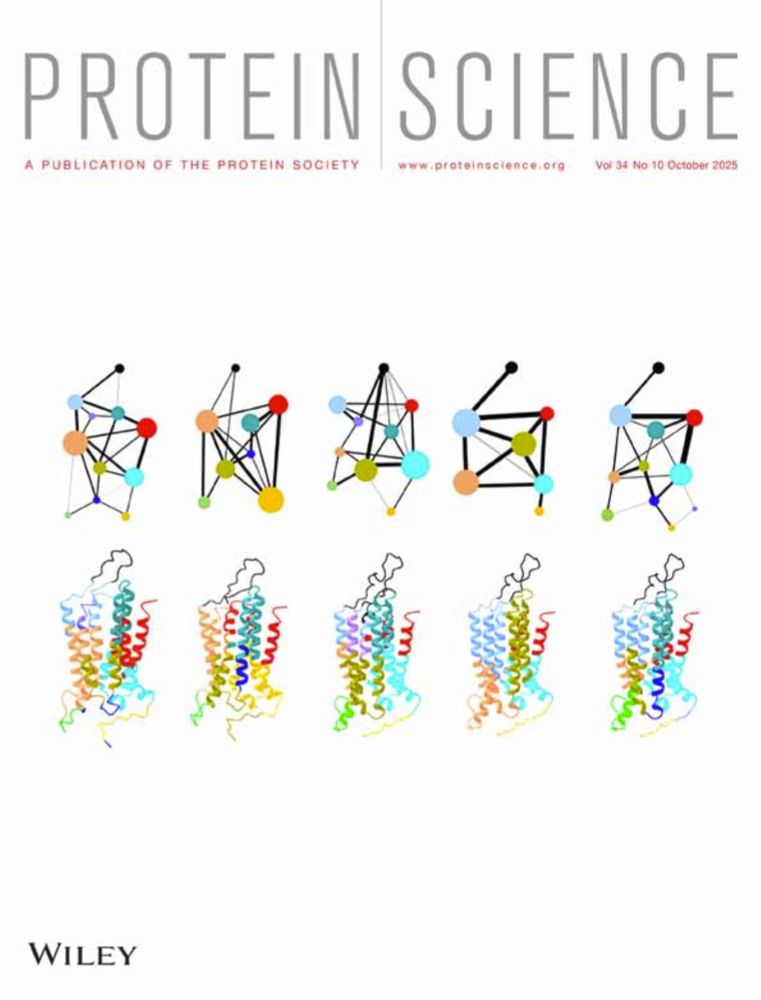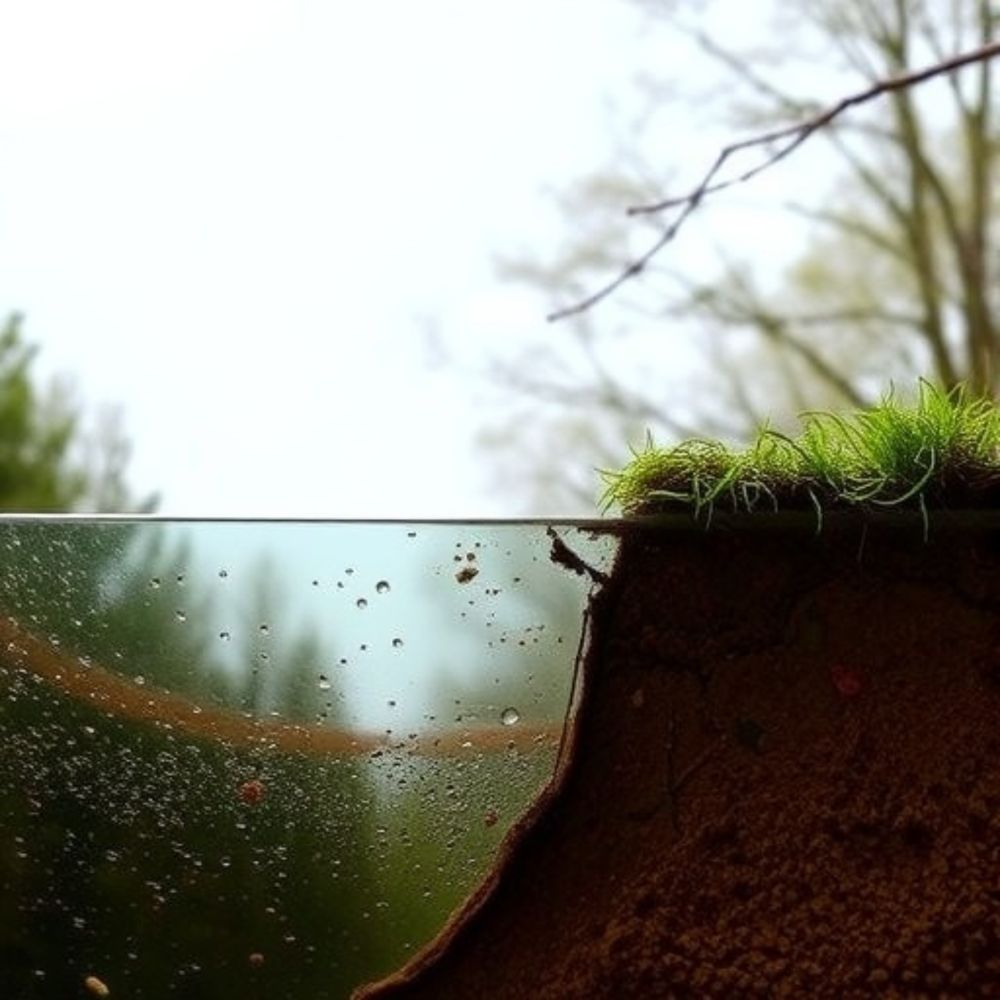Topics:
- plastic-associated chemicals from weathering plastics
- insights into the outcomes of the P-LEACH project
- profiles & effects of chemicals from plastics
- custom-made plastics & consumer plastics were studied
- analytical & bioanalytical toolboxes for leachates characterisation
23.10.2025 08:37 — 👍 0 🔁 0 💬 0 📌 0
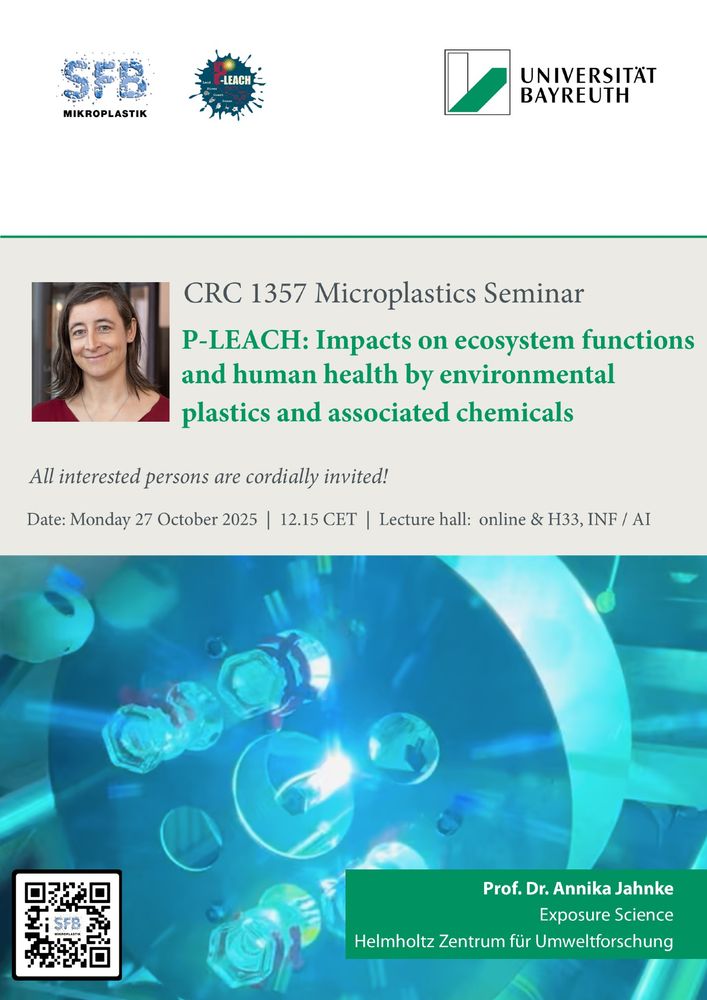
CRC 1357 Microplastics Seminar – Open & Hybrid!
🎤 Prof. Dr. Annika Jahnke @ufz.de
P-Leach Impacts on ecosystem functions & human health by environmental plastics & associated chemicals
🗓 27.10.25
⏰ 12.15 CET
💻 Join on site or online
📩 Subscribe to our Newsletter for Zoom Links
Funded by @dfg.de
23.10.2025 08:37 — 👍 2 🔁 0 💬 1 📌 0

Great to see that data from lake studies can be further developed to understand also other transport pathways of microplastics.
This study provides novel insights into microplastic retention in drinking water reservoirs & underscores the vulnerability of such systems to episodic transport events.
15.10.2025 08:44 — 👍 0 🔁 0 💬 0 📌 0
Trapping of microplastic particles in Germany’s largest drinking water reservoir: a simulation study | Environmental Sciences Europe
📣New CRC 1357 Publication: Trapping of microplastic particles in Germany’s largest drinking water reservoir: a simulation study rdcu.be/eK6rK
Joint work between @crc1357.bsky.social @unibayreuth.bsky.social and @ufz.de!
#Microplastics #CRCMP #WaterScience #Research #Modeling #KnowledgeExchange
15.10.2025 08:44 — 👍 1 🔁 0 💬 1 📌 0

#Forschungsbewertung im Fokus
Die Veranstaltung am 10.09.25 bot Raum für Austausch: Warum sind Reformen nötig? Welche Chancen und Herausforderungen ergeben sich daraus? Und welchen Mehrwert bietet eine Mitgliedschaft in der internationalen CoARA – Coalition for Advancing #ResearchAssessment?
07.10.2025 09:57 — 👍 6 🔁 3 💬 1 📌 0
📅 Today! 👇 💡
14.10.2025 07:02 — 👍 13 🔁 9 💬 0 📌 0
Since its 2021 launch, ToMEx has enabled global researchers to explore, visualize, and analyze microplastics toxicity data for hazard and risk assessment. With rapidly growing literature, an international crowd-sourcing effort was organized to systematically update ToMEx. Important team work💪.
10.10.2025 11:10 — 👍 0 🔁 0 💬 0 📌 0

The Toxicity of Microplastics Explorer (ToMEx) 2.0 - Microplastics and Nanoplastics
In 2021 the Toxicity of Microplastics Explorer (ToMEx, https://microplastics.sccwrp.org ) was released as an open source, open access database and web application for microplastics toxicity. Since then, it has been utilized by the microplastic research community for the exploration, visualization, and analysis of toxicity data for both hazard characterization and risk assessment. The peer-reviewed literature has continued to grow exponentially, making ToMEx out-of-date. To ensure the continued utility of ToMEx, an international crowd-sourcing approach was utilized to update ToMEx by extracting data from additional studies published since the original release. Through this process, both the aquatic and human health ToMEx databases roughly doubled in size, and modest increases in data diversity (e.g., number of species represented, types of test particles) were observed in the aquatic organisms database. However, most trends (e.g., greater toxicities observed with smaller particle sizes, lack of dose–response data etc.) observed in the first iteration of ToMEx remained constant. A previously developed framework for deriving ecological health-based microplastic thresholds using species sensitivity distributions was reapplied to determine how thresholds and their associated uncertainty intervals would change following the database update. Twelve new studies passed minimum screening criteria and were deemed fit for the purpose of threshold derivation. The addition of new data allowed for the separation of freshwater and marine compartments which had previously been combined due to a lack of applicable toxicity data for freshwater species. When molecular and cellular level endpoints were included, freshwater thresholds were comparable or increased from values calculated using previous data (-5 to 2.5-fold change) whereas marine thresholds dramatically decreased (-5000 to -29-fold change). However, when endpoints were restricted to organism and above, marine and freshwater thresholds were comparable to those calculated previously (-20 to 14-fold change). Confidence intervals for both marine and freshwater thresholds remained wide. The doubling of the database increases the value of ToMEx for researchers, particularly those focused on characterizing hazards associated with microplastics. Its utility remains limited for environmental managers as 89% of studies in ToMEx 2.0 failed to meet minimum screening criteria for threshold derivation, highlighting the need to generate fit-for-purpose toxicity data for threshold development. However, ToMEx continues to be a useful research tool, and future iterations could become even more powerful through novel artificial intelligence applications to streamline data curation and even predict toxicological outcomes.
🚀 Update on Microplastics Toxicity Research - ToMEx 2.0 Release!
The open-source Toxicity of Microplastics Explorer received a major expansion. Congrats to all authors that contributed to this international coop led by Leah Thornton Hampton.
🔎 microplastics.springeropen.com/articles/10....
10.10.2025 11:10 — 👍 0 🔁 0 💬 1 📌 0
This #meta-analysis adds valuable insights into how micro- and #nanoplastics affect reproduction in #Daphnia. An important step toward understanding #ecosystem-level impacts of #plastic #pollution.
Great work!!
#Microplastics #Ecotoxicology #BayCEER
06.10.2025 08:27 — 👍 4 🔁 3 💬 0 📌 0

Graphical Abstract showing how surface charge changes upon weathering.
💡 The surface charge of particles larger than 10 microns can't be studied like small colloidal particles using electrophoretic mobility.
Streaming potential method allows to study this crucial parameter for environmental relevant particles!
02.10.2025 09:07 — 👍 0 🔁 0 💬 0 📌 0
📣 New CRC 1357 Microplastics Publication: Following Changes at the Solid/Liquid Interface for Large Microplastic Particles by Streaming Potential published in Chemistry Methods.
Congrats to this interdisciplilnary study including 5 project teams @unibayreuth.bsky.social!
doi.org/10.1002/cmtd...
02.10.2025 09:07 — 👍 0 🔁 0 💬 1 📌 0
YouTube video by Universität Wien
🧗♂️ Rubber chemicals in climbing shoes: A hidden health risk? 🧪🌬️
In this video, environmental scientists Anya Sherman and Thilo Hofmann from the University of Vienna explain the results of their study: ⤵️
www.youtube.com/watch?v=f3WO...
29.04.2025 12:52 — 👍 9 🔁 4 💬 0 📌 1

The Moore Institute for Plastic Pollution Research
is seeking a visionary and compassionate leader to serve as Executive Director of their laboratory. Truly an incredible opportunity to work with some of the world's leading researchers on #microplastics!
Apply by October 31st! <- lnkd.in/g2u_pJxs
17.09.2025 21:25 — 👍 2 🔁 2 💬 0 📌 0
❓How do cells transport microparticles?
🔎microplastic particles between 1 & 5 µm
💡 first systematic investigation of intracellular transport forces in this size range
💡 first quantitative assessment of the numbers of molecular motors involved
💪new insights how cells respond to microplastics
01.10.2025 06:53 — 👍 0 🔁 0 💬 0 📌 0
📣New CRC 1357 open access article! Congrats go to Simon Wieland & co-authors for their new article "Many dynein teams collectively generate high forces during the transport of large organelles" published in the Biophysical Journal!
doi.org/10.1016/j.bp...
#microplastics #celltransport #dynein
01.10.2025 06:53 — 👍 0 🔁 0 💬 1 📌 0

Save the Date 📅 Infoveranstaltung der #DFG zu #Chancengleichheit und #Diversität für alle interessierten Wissenschaftler*innen: "Relevanz von Geschlecht und Diversität im Forschungsvorhaben" am 8. Oktober 2025, 13 Uhr.
Infos und Meeting-Link: https://sohub.io/xx7s
30.09.2025 12:02 — 👍 20 🔁 5 💬 1 📌 0

🚨 Nice shiny new proof 👇
Emerging challenges of microplastic impacts to ecological health and climate change
#Microplastics
#GreenhouseGasEmissions
#Ecologicalrisk
#ClimateChange
#Carboncycling
#Plasticpollution
30.09.2025 12:21 — 👍 7 🔁 2 💬 0 📌 0
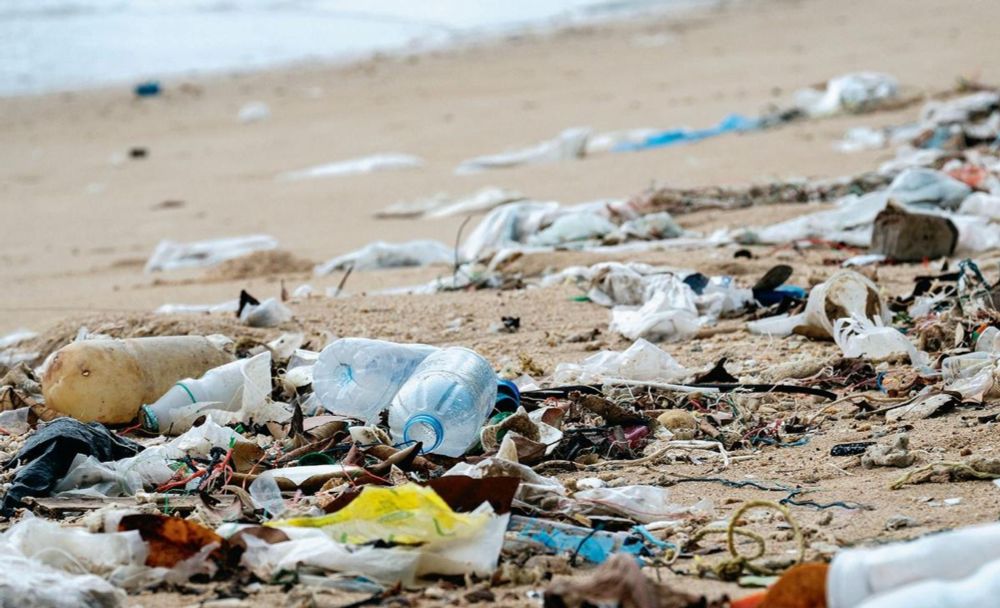
Plastik: Die Vermüllung des Planeten – Deutsches Ärzteblatt
📚 Lesetipp: Plastik – Die Vermüllung des Planeten
Der Artikel von Falk Osterloh im Deutschen Ärzteblatt beleuchtet die weltweiten Folgen der Plastikverschmutzung auf Umwelt & Gesundheit sowie Lösungsansätzen. Interviewpartner: Christian Laforsch👍
Zum Artikel:
www.aerzteblatt.de/archiv/plast...
29.09.2025 11:44 — 👍 0 🔁 0 💬 0 📌 0
The Rising Danger of AI-Generated Images in Nanomaterials Science – Experts Warn in Nature Nanotechnology
The Rising Danger of AI-Generated Images in Nanomaterials Science – Experts Warn in Nature Nanotechnology www.idw-online.de/-DRgoAA
29.09.2025 07:00 — 👍 2 🔁 0 💬 0 📌 0
Congrats to our CRC 1357 colleagues A. Fery & G.Auernhammer co-authored the comment "The rising danger of AI-generated images in nanomaterials science & what we can do about it"
A good moment to highlight our CRC 1357 Microplastics community zenodo.org/communities/...
29.09.2025 06:36 — 👍 2 🔁 0 💬 1 📌 0
📣New CRC 1357 Microplastics Publication: The Fate of Biodegradable Plastic Items Under Conditions of State-of-the-Art Composting by Lisa-Cathrin Leitner, T Steiner, R Freitag & A Greiner @unibayreuth.bsky.social
www.mdpi.com/3483718
#compost #biodegradation #PLA #PBAT #crystallinity #microplastics
29.09.2025 05:23 — 👍 1 🔁 0 💬 0 📌 0
Must read if your are interested in:
💡 Role of biological activity & soil structure for #microplastic translocation
💡~ 84% of all microplastics have been vertically translocated & ~ 800,000 MP/kg accumulate in 38 to 45 cm soil depth.
💡Size related microplastic distribution
🔎 #FTIR #Bioturbation
25.09.2025 09:31 — 👍 1 🔁 0 💬 0 📌 0

Vertical distribution and post-depositional translocation of microplastics in a Rhine floodplain soil - Microplastics and Nanoplastics
Microplastics (MPs) are ubiquitous in the environment, but their vertical movement in undisturbed soils is poorly understood. This study investigates MP distribution and transport in one 110 cm soil profile from a Rhine River floodplain, Germany. Nine soil samples were analyzed for MP content, grain size distribution, bulk density, porosity, and organic carbon content. MPs (10 $$\upmu$$ μ m to 5 mm) were characterized by size, shape, and polymer type using ATR-FTIR and $$\upmu$$ μ FTIR. Biological activity was assessed through earthworm species identification and abundance, and sediment deposition was dated using optically stimulated luminescence (OSL). To our knowledge, this is one of the first studies to integrate detailed field observations with dating results to draw conclusions about the vertical displacement of microplastics. MPs were detected at all depths, with 81.3%–96.6% being 10–150 $$\upmu$$ μ m in size, predominantly fragments and spheres. Concentrations peaked at 790,497 particles $$kg^{-1}$$ k g - 1 dry soil between 38 and 45 cm, where root- and earthworm-formed macropores facilitated transport. Below this depth, reduced porosity limited movement, favoring smaller MPs. OSL dating indicated sedimentation before the 1950s/60s below 20 cm, suggesting vertical transport of MPs. Therefore, we would advise to be careful using small MPs as stratigraphic markers for the Anthropocene. Although analysing just one soil profile, this study highlights the role of biological activity and soil structure in MP translocation and emphasizes the need to account for small MPs in floodplain studies to avoid underestimating their environmental presence. Graphical Abstract
📢 New research article in Microplastics & Nanoplastics
@springer.springernature.com by our former master student
@paulineseidel.bsky.social: Vertical distribution & post-depositional translocation of microplastics in a Rhine floodplain soil
📖👉 microplastics.springeropen.com/articles/10....
25.09.2025 09:31 — 👍 3 🔁 2 💬 2 📌 0
Vertical distribution and post-depositional translocation of microplastics in a Rhine floodplain soil
First publication - check! 😍 Still can’t believe it happened!
My road to the 1st paper:
2022: Lab work done 🥼
2023: First draft 📑
2024: Final draft & first journal submission ✔️
2025: Two other journals later: Publication! 💥
Huge thanks to my co-others! Science is team-work 💪🏼
➡️ rdcu.be/eAFhd
21.08.2025 06:29 — 👍 6 🔁 2 💬 1 📌 0
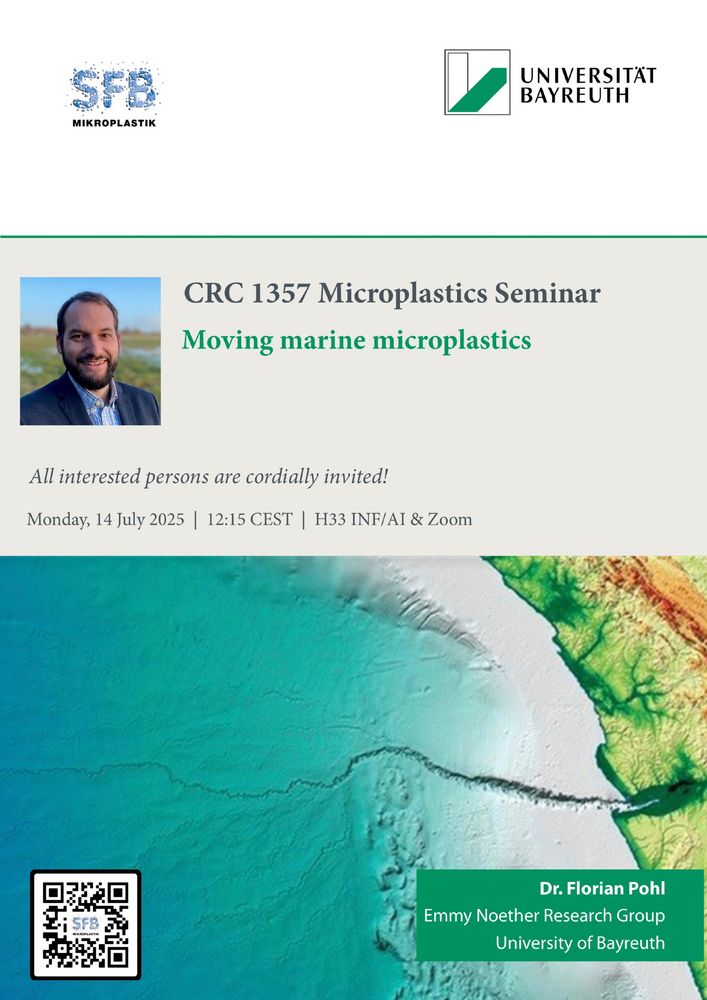
Looking forward to today's CRC Microplastics seminar with Dr. Florian Pohl @plasticsediment.bsky.social talking about "Moving marine microplastics"! Start 12.15 CEST at @unibayreuth.bsky.social H 33 (AI/INF) & ZOOM.
Students & colleagues from all disciplines are welcome!
14.07.2025 09:34 — 👍 2 🔁 0 💬 0 📌 0

🌍 This Thursday at the BayCEER Colloquium:
Dr. Magdalena Mair presents data-driven tools for assessing risks of chemicals and microplastics, featuring predictive models, machine learning & more.
Info: www.bayceer.uni-bayreuth.de/bayceer/en/a...
@crc1357.bsky.social
@magdalenammair.bsky.social
08.07.2025 05:09 — 👍 3 🔁 1 💬 0 📌 0
Thanks for mirroring😊
But you also need to consider recording & storing videos does require server space, costs money, & takes extra effort. We want to keep our events interactive—live discussions & exchange are key for evolving knowledge. If everything is just watched later, we lose that dynamic.
02.06.2025 14:32 — 👍 1 🔁 0 💬 0 📌 0
Soil scientist at Natural Resources Institute Finland, Luke
Maaperätutkija Luonnonvarakeskuksessa
Geologist, Geobiologist, Prof.em., 🧪marine Ecosystems, Anthropocene Working Group, CultureNatureLiteracy and Ethics in the Anthropocene, Futures Research, Museology, Education, Communication; Exhibitions, Science Comics (FU-Berlin, PHNOE Baden/Austria)
Professor, ecology, FU Berlin, own views, book author
Global change, soil, fungi, environment, microplastic, biodiversity 🧪
https://www.youtube.com/@mrillig
https://www.youtube.com/@lifeinthesoil
rilliglab.org
https://matthiasrillig.substack.com
Author of Malthus Enigma: Technology, Science, and Policy for a Fragile Earth
Web development, data management and visualizations. Consulting services for scientific and r&d communities. https://www.researchelements.org/
NGOWork - Deine Jobbörse mit Impact. Finde sinnstiftende Arbeit, News und ein Netzwerk im NGO Bereich. www.ngowork.de
assoc prof political science at #Northeastern; political economy; comparative regulation & governance; environmental justice; micro & nano plastics; #PlasticsTreaty, funk nite queen; mother of 2 kids & dog
#microplastic researcher with a focus on terrestrial ecosystems and air pollution.
Assoc prof @universityofleeds.bsky.social| Medical doctor & Interdisciplinary social scientist| digital health | Urban Health | One Health| Participatory methods | Realist methods
For details see: http://bit.ly/2Uvaa04-Bassey-UoL
Empowering communities and inspiring industries to integrate biochar-based solutions towards healthier ecosystems and economies worldwide.
CREAF-Autonomous University of Barcelona
Soil science and ecology, ecotoxicology, and biochar
Science at the interface of biology, chemistry and photonics, discovering new applications of microscopic lasers and sensors. Part of the Humboldt Centre for Nano- and Biophotonics, University of Cologne. PI posting. https://schubert-lab.uni-koeln.de/
Enviro' Toxicologist | Research Scientist @OEHHA | #Microplastics | @ToMExApp dev | @ThePlastiverse founder | RYT:200 | DJ | Surfer | Views Own | he/him | 🌈∞
Publishing expertise since 1842.
An open access @NaturePortfolio journal publishing high-quality primary research articles, reviews and commentary in all areas of the chemical sciences.
nature.com/commschem/
A journal publishing reviews and commentaries across all aspects of materials science. Posts from the editors, @giulia-pacc.bsky.social, arianevartanian.bsky.social and Charlotte Allard. https://www.nature.com/natrevmats/
A Nature journal publishing research and commentary on all aspects of food production, processing, distribution & consumption that contribute to food security and sustainable food systems.
https://www.nature.com/natfood/
A journal covering natural, social, engineering and technology fields about sustainability, its policy dimensions and viable solutions.
Part of Nature Portfolio.
https://www.nature.com/natsustain/











